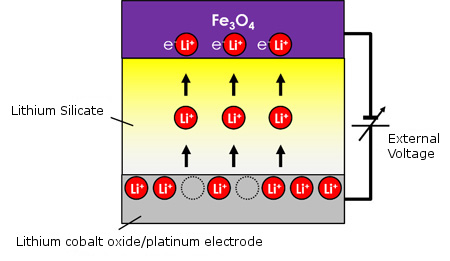Low-Current, Highly Integrable Spintronics Device Developed

Figure: Diagram showing the mechanism of the technique developed in this study. External voltage is applied to insert/remove lithium ions present in the solid electrolyte (lithium silicate) into/from the magnetic material (Fe3O4) to tune magnetoresistance and magnetization. Copyright : NIMS
A research team at National Institute for Materials Science (NIMS) Materials Nanoarchitectonics (MANA) and Tokyo University of Science, Japan, jointly developed a device capable of controlling magnetism at a lower current level than conventional spintronics devices.
The new device was fabricated by combining a solid electrolyte with a magnetic material, and enabling insertion/removal of ions into/from the magnetic material through application of voltage.
A research team of International center for Materials Nanoarchitectonics (MANA), consisting of postdoctoral fellow Takashi Tsuchiya (currently at Tokyo University of Science), group leader Kazuya Terabe, and Director Masakazu Aono, developed a device capable of controlling magnetism at a lower current level than conventional spintronics devices, with lecturer Tohru Higuchi at Tokyo University of Science.
The new device was fabricated by combining a solid electrolyte with a magnetic material, and enabling insertion/removal of ions into/from the magnetic material through application of voltage. Because the device has a simple structure and is capable of high integration, it may lead to the development of totally new high-density high-capacity memory devices with low power consumption.
High-density high-capacity recording (memory) devices for storage of a vast amount of data have become important due to the information explosion today. Spintronics devices, which utilize characteristics of both the charge and spin of electrons to record information, are attracting much attention as a type of memory device.
However, it has been pointed out that the spintronics elements are difficult to use in high integration due to their complex structures and they require a high level of write current.
Using a lithium ion conducting solid electrolyte, the research group inserted/removed lithium ions into/from the Fe3O4 magnetic material to change the electronic carrier density and electronic structure of the magnetic material. By doing so, the research group successfully tuned magnetic properties including magnetoresistance and magnetization.
The technique developed in this study, which takes advantage of ionic motion, enables spintronics devices to control magnetism at a lower current level than conventional devices, allows them to have a simple structure, and makes them capable of high integration.
Furthermore, the whole of the device is made of solid materials, preventing liquid leakage from occurring. Because of these advantageous features, this technique is expected to enable the development of high-density high-capacity memory devices with low power consumption, using conventional semiconductor processes.
Based on these results, the research group will make further progress in the development of microfabrication techniques to achieve high integration, and conduct demonstration experiments aiming to apply this technique to high-density high-capacity memory devices.
This study was published in the online version of ACS NANO on January 6, 2016 (Japan time).
Associated links
Media Contact
More Information:
http://www.researchsea.comAll latest news from the category: Materials Sciences
Materials management deals with the research, development, manufacturing and processing of raw and industrial materials. Key aspects here are biological and medical issues, which play an increasingly important role in this field.
innovations-report offers in-depth articles related to the development and application of materials and the structure and properties of new materials.
Newest articles

First-ever combined heart pump and pig kidney transplant
…gives new hope to patient with terminal illness. Surgeons at NYU Langone Health performed the first-ever combined mechanical heart pump and gene-edited pig kidney transplant surgery in a 54-year-old woman…

Biophysics: Testing how well biomarkers work
LMU researchers have developed a method to determine how reliably target proteins can be labeled using super-resolution fluorescence microscopy. Modern microscopy techniques make it possible to examine the inner workings…

Making diamonds at ambient pressure
Scientists develop novel liquid metal alloy system to synthesize diamond under moderate conditions. Did you know that 99% of synthetic diamonds are currently produced using high-pressure and high-temperature (HPHT) methods?[2]…





















